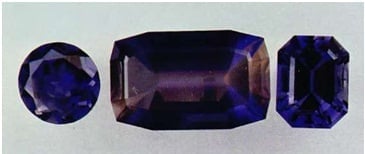Cordierite Value, Price, and Jewelry Information
The crystal structure of cordierite has many similarities to that of beryl; indialite, the dimorph, in fact has the same structure as beryl. Iolite with hematite inclusions (bloodshot iolite) comes from Sri Lanka. The inclusions sometimes yield a gem showing a 4-rayed star (quite rare). The blue color of iolite along one optical direction strongly resembles sapphire, and such gems, correctly oriented in settings, are often confused with sapphires. Iolite is not a very rare material, but stones that are completely clean over 10 carats are quite uncommon, and clean 15-20 carat gems are worthy of museum display.
1 Minute Read
The crystal structure of cordierite has many similarities to that of beryl; indialite, the dimorph, in fact has the same structure as beryl. Iolite with hematite inclusions (bloodshot iolite) comes from Sri Lanka. The inclusions sometimes yield a gem showing a 4-rayed star (quite rare). The blue color of iolite along one optical direction strongly resembles sapphire, and such gems, correctly oriented in settings, are often confused with sapphires. Iolite is not a very rare material, but stones that are completely clean over 10 carats are quite uncommon, and clean 15-20 carat gems are worthy of museum display.
Start an IGS Membership today
for full access to our price guide (updated monthly).Cordierite Value
Gem names: lolite; Water Sapphire. Dimorph of Indialite.
Optics: a = 1.522-1.558; β = 1.524-1.574; γ= 1.527-1.578. (Sri Lanka: a = 1.530; β= 1.534; γ = 1.539; Birefringence = 0.009; S.G. = 2.58). Biaxial (+), 2V= 65-104°. Frequently optically (-).
Inclusions: Crystals of apatite and zircon, the latter with pleochroic haloes, the outer edges of which are deep yellow. Frequently dustlike masses of tiny crystals. Also hematite plates in parallel orientation (from Sri Lanka) impart a red color, and gems are sometimes called bloodshot iolite.
Occurrence: In altered aluminous rocks; igneous rocks; alluvial gravels.
California; Idaho; Wyoming; South Dakota: New York; New Hampshire.
Great Slave Lake. Canada: Greenland: Scotland; England; Norway, Germany; Finland.
Connecticut: gemmy material that cuts up to 2 carats.
Madras, India: gem iolite in abundance.
Sri Lanka and Myanmar: gemmy material from the gem gravels.
Paraiba, Brazil: some gemmy material from Virgolandia, in nodules.
Babati, Tanzania: gem material.
Karasburg, Namibia: gem material. Madagascar; Japan: Australia.
Comments: The crystal structure of cordierite has many similarities to that of beryl; indialite, the dimorph, in fact has the same structure as beryl. Iolite with hematite inclusions (bloodshot iolite) comes from Sri Lanka. The inclusions sometimes yield a gem showing a 4-rayed star (quite rare). The blue color of iolite along one optical direction strongly resembles sapphire, and such gems, correctly oriented in settings, are often confused with sapphires. Iolite is not a very rare material, but stones that are completely clean over 10 carats are quite uncommon, and clean 15-20 carat gems are worthy of museum display.
Name: After Mr. Cordier, a French geologist who first studied its crystals. Iolite is from Greek ios(Violet) and lithos (stone).
Joel E. Arem, Ph.D., FGA
Dr. Joel E. Arem has more than 60 years of experience in the world of gems and minerals. After obtaining his Ph.D. in Mineralogy from Harvard University, he has published numerous books that are still among the most widely used references and guidebooks on crystals, gems and minerals in the world.
Co-founder and President of numerous organizations, Dr. Arem has enjoyed a lifelong career in mineralogy and gemology. He has been a Smithsonian scientist and Curator, a consultant to many well-known companies and institutions, and a prolific author and speaker. Although his main activities have been as a gem cutter and dealer, his focus has always been education. joelarem.com
Related Articles
What is Gemstone Pleochroism?
Iolite Buying Guide
Black Diamond Value, Price, and Jewelry Information
Chameleon Diamond Value, Price, and Jewelry Information
Latest Articles
Quartz Toxicity: Understanding the Risks for Jewelers and Wearers
Synthetic Amethyst: What is it and How is it Made?
Hambergite Value, Price, and Jewelry Information
Pearl Simulants: How to Spot Faux Pearls
Never Stop Learning
When you join the IGS community, you get trusted diamond & gemstone information when you need it.
Get Gemology Insights
Get started with the International Gem Society’s free guide to gemstone identification. Join our weekly newsletter & get a free copy of the Gem ID Checklist!
